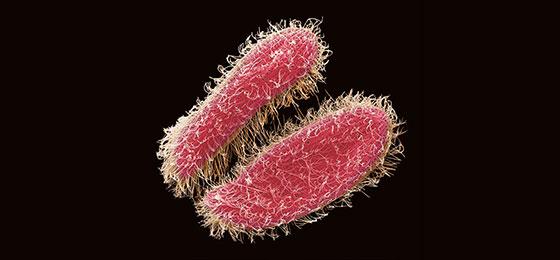The genetic clear-out

Paramecia have genetic elements that can eliminate themselves – junk DNA with a self-destruct mechanism. By Ori Schipper
(From "Horizons" no. 114 September 2017)
Der The greatest part of the genetic material of higher organisms comprises junk DNA. This genetic 'clutter' contains no blueprints for proteins. Researchers have been discussing for decades why this is so, and what biological significance these non-coding genetic building blocks might have.
A group led by Mariusz Nowacki at the Institute of Cell Biology at the University of Bern has been investigating how paramecia deal with these DNA sequences, which are often regarded as being parasitic. Their findings seem paradoxical at first: these water-dwelling, single-cell organisms use these genetic elements in order to dispense with the same sequences themselves. In other words, the 'junk' is used to clear itself out.
Cell nuclei times 800
Paramecia are particularly suited for experiments into the role of junk DNA, because they have two types of cell nucleus: a micronucleus and a macronucleus. The micronucleus teems with non-coding DNA sequences. It contains the germ line genome. This is not used for the production of proteins, but is used exclusively for purposes of asexual reproduction.
The macronucleus, on the other hand, contains more than 800 working copies of the genome. These are optimised for the immediate needs of the paramecia. In order to create the macronucleus, the genetic material of these organisms is, at one and the same time, copied and de-cluttered. The copies contain a compact, clean copy of all the paramecia genes, from which the junk sequences have been eliminated. But in the long term, these optimised copies are unstable. "That is why the paramecia now and again reproduce sexually – and subsequently create a new macronucleus", says Nowacki. The junk then has to be eliminated all over again.
Up to now, scientists had supposed that the non-coding DNA fragments – cut out of the germ line genome by the single-cell organisms to create a new macronucleus – were broken down and destroyed. But this is not the case, as Nowacki and his team have proven. "The paramecia glue the eliminated fragments together and make rings and loops with them", says Nowacki. Upon reading these junk-DNA collages, they then create search templates that enable them to locate and remove further parasitic elements in their self-copying genetic material.
The more cut-out sequences they find, the quicker they can find other parasitic elements, too – a kind of positive feedback process. This method of arresting undesired genetic elements in order to use them to search for further sequences in the genetic material can also be found in the cells of animals and plants. In this manner, they can 'switch off' or shut down parts of their genetic material. This could be a mechanism that in general plays an important role in defending genetic material against deposits of parasitic elements.
This is also the opinion of Rebecca Zufall, an evolutionary biologist who is researching into the architecture of the genetic material of an organism related to the paramecia. She is admiring of the work being done in Switzerland: "They're presenting a clean model of positive feedback and signal amplification that makes sense in the context of the double genome of these single-cell organisms".
Ori Schipper works for the Swiss Cancer League and as a freelance journalist.
S. E. Allen et al.: Circular Concatemers of Ultra-Short DNA Segments Produce Regulatory RNAs. Cell (2017)